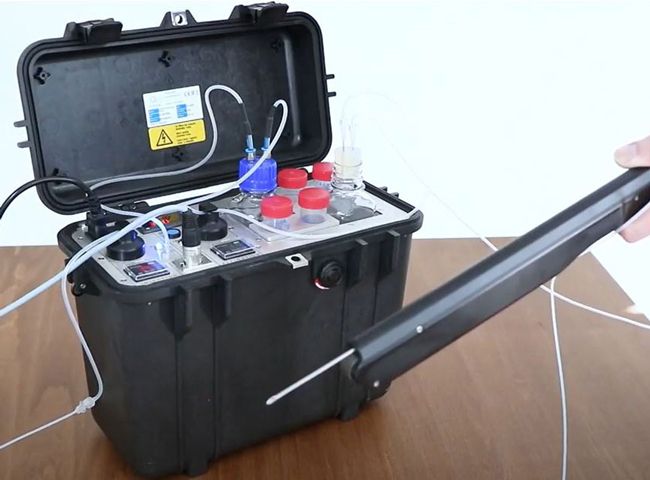Ovum pick-up in the mare
Ultrasound-guided transvaginal oocyte aspiration represents a non-invasive method for obtaining equine oocytes. In practice, this technique has now almost replaced the more invasive laparoscopic techniques.
Ovum pick-up followed by in vitro embryo production procedure (OPU-IVP) is strongly driven by the need of the breeding industry to continually promote genetic improvement. Successful OPU-IVP programs are desired to increase the number of embryos and offspring per donor which subsequently allows enhanced selection intensity for the next generation. Combining genome testing and sexed semen may also be a strategy to minimize the time required to generate replacements for elite females. The number of elite candidates is increased by using repeated flushes during the multiple ovulation embryo transfer and ovum pick-up programs.
With the OPU technique, oocytes (eggs) are retrieved directly from the follicle of an ovary – using an ultrasound device equipped with a needle. The ultrasound helps visualize the ovary and guides the needle to the follicle containing the oocytes. A probe carrier keeps the needle in the right place in the vagina along with the probe of the ultrasound machine. In addition, a pump is needed to facilitate the aspiration of the oocyte from the follicle. In contrast to OPU in cattle, where simple aspiration of the follicle is sufficient to retrieve oocytes, each follicle of a mare must be injected and aspirated 6-10 times while scratching the walls of the follicle with the needle to retrieve the oocyte. In that way 16 to 20 follicles (<5 mm) are flushed per mare/session.
Following the retrieval of oocytes, the production of embryos from the oocytes is performed. This is done in an ICSI lab (ICSI – intra-cytoplasmic sperm injection), and usually the oocytes are transported to such a lab, which is equipped with high sophisticated equipment. After collection and/or transport the oocytes will be matured under certain conditions. Those IVM (in vitro maturation) oocytes will then be injected with a single sperm cell and finally cultured for 7-8 days when they reach blastocyst stage. Then they can be either transferred or frozen/vitrified.
Besides artificial insemination, embryo transfer is the most established technique in assisted reproduction. Despite low number of embryos due to insufficient success in superovulation of mares, embryo transfer is used because it allows valuable mares and mares going in competitions to produce foals.
Some more reasons:
For successful performance of OPU, Minitube offers professional, high-quality, and user-friendly equipment such as an OPU pump for follicular aspiration with media warmer, probe carriers and a double-lumen puncture needle, each specially designed for use in mares. Minitube's EquiPlus OPU recovery medium is presented as a ready-to-use solution and manufactured under strict quality guidelines in a dedicated clean room.
Ovum pick-up followed by in vitro embryo production procedure (OPU-IVP) is strongly driven by the need of the breeding industry to continually promote genetic improvement. Successful OPU-IVP programs are desired to increase the number of embryos and offspring per donor which subsequently allows enhanced selection intensity for the next generation. Combining genome testing and sexed semen may also be a strategy to minimize the time required to generate replacements for elite females. The number of elite candidates is increased by using repeated flushes during the multiple ovulation embryo transfer and ovum pick-up programs.
With the OPU technique, oocytes (eggs) are retrieved directly from the follicle of an ovary – using an ultrasound device equipped with a needle. The ultrasound helps visualize the ovary and guides the needle to the follicle containing the oocytes. A probe carrier keeps the needle in the right place in the vagina along with the probe of the ultrasound machine. In addition, a pump is needed to facilitate the aspiration of the oocyte from the follicle. In contrast to OPU in cattle, where simple aspiration of the follicle is sufficient to retrieve oocytes, each follicle of a mare must be injected and aspirated 6-10 times while scratching the walls of the follicle with the needle to retrieve the oocyte. In that way 16 to 20 follicles (<5 mm) are flushed per mare/session.
Following the retrieval of oocytes, the production of embryos from the oocytes is performed. This is done in an ICSI lab (ICSI – intra-cytoplasmic sperm injection), and usually the oocytes are transported to such a lab, which is equipped with high sophisticated equipment. After collection and/or transport the oocytes will be matured under certain conditions. Those IVM (in vitro maturation) oocytes will then be injected with a single sperm cell and finally cultured for 7-8 days when they reach blastocyst stage. Then they can be either transferred or frozen/vitrified.
Besides artificial insemination, embryo transfer is the most established technique in assisted reproduction. Despite low number of embryos due to insufficient success in superovulation of mares, embryo transfer is used because it allows valuable mares and mares going in competitions to produce foals.
Why can ovum pick-up be the better alternative to embryo collection and transfer?
The technique can make it possible to obtain foals from mares, that- cannot become pregnant
- do not get in heat
- are pregnant
- are going in competitions
- have a very high genetic potential
Some more reasons:
- OPU can be done year-round
- Oocytes of 100 mares can produce ICSI embryos with one single semen straw (very important for deceased stallions)
- With ICSI offspring of sub- or even infertile stallions can be produced
- ICSI embryos are much easier to freeze or vitrify than flushed embryos
- Embryo flushing in the mare results in 1 embryo, with OPU the mean value is 2 embryos per session (range from 0-13)
For successful performance of OPU, Minitube offers professional, high-quality, and user-friendly equipment such as an OPU pump for follicular aspiration with media warmer, probe carriers and a double-lumen puncture needle, each specially designed for use in mares. Minitube's EquiPlus OPU recovery medium is presented as a ready-to-use solution and manufactured under strict quality guidelines in a dedicated clean room.














